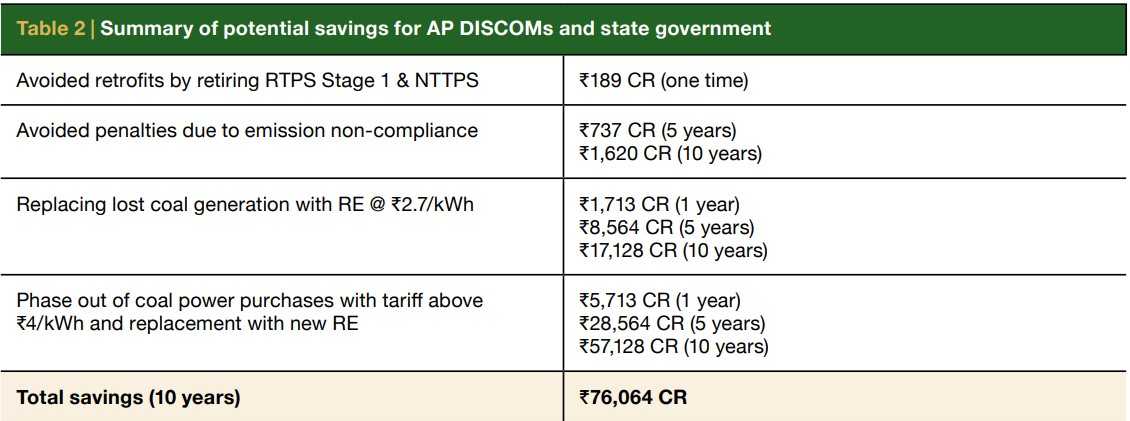Renewable energy transition can save Andhra Pradesh ₹76,000 CR
Andhra Pradesh can save over ₹76,000 CR in the coming decade by retiring old coal units as part of a planned energy transition, while still meeting the state’s growing energy requirements, according to research by think tank Climate Risk Horizons.
The analysis provides a roadmap for a financially beneficial energy transition for the state, where distribution companies have been struggling with high losses. Replacing expensive coal units with cheaper renewable energy has three-fold benefits of reducing electricity costs for consumers, improving the financial performance of distribution companies, and helping the state achieve its renewable energy targets. The findings are also significant in light of the recent Ministry of Power mandate requiring all new coal power plants to set up renewable energy capacity equivalent to 40% of the plant’s capacity.
The report, titled ‘Retiring to Save’, highlights three factors that make Andhra Pradesh an ideal candidate to lead the energy transition: surplus coal power capacity, extremely cheap renewables coupled with falling costs of battery storage systems, and the 2025 deadline for mandatory coal plant retrofits.
“With its plentiful renewable resources and proactive energy policies, our analysis suggests that careful planning and investments can allow Andhra Pradesh to start phasing out old coal plants at a net reduction in power purchase costs, resulting in long term financial benefits for DISCOMs and the state government”, said Ashish Fernandes, CEO of Climate Risk Horizons.
The study estimates that retiring 8 coal units totalling 1680 MW at the Rayalseema Thermal Power Station, Cuddapah and Dr. Narla Tata Rao Thermal Power Station, Vijaywada can yield savings of ₹9,500 crores over 5 years. It further estimates that in the longer term, if scheduled generation from all plants with tariffs at ₹4/kWh or higher were to be gradually replaced with power from renewables at an average of ₹2.7/kWh, there would be an additional potential savings of over ₹57,000 crores over ten years. These savings can go a long way in augmenting the state’s revenue and help cover the cost of providing free electricity for agriculture, free water pumps, subsidized solar installations and cash transfers to farmers.
“With the significant rise in installed power capacity over the last decade, the state now has surplus generation capacity in the state, with coal plants running at less than 60% Plant Load Factor. Due to fresh capacity addition in the pipeline (both renewables and thermal) retiring the older coal units will not impact ability to meet electricity demand growth. AP’s ambitious renewable energy programme will enable the state to meet even aggressive projections for electricity demand growth from clean energy alone,” said Vishnu Teja of CRH, co-author of the report.
At a time when state budgets are stressed, the savings from a planned energy transition can be used to meet critical budgetary needs. For example, the report says, the annual savings from replacing older, expensive coal power with renewables could be used to meet the planned allocations for solar PV to provide free electricity for agriculture, or the subsidy for nearly 2 crore roof top solar installations.
Andhra Pradesh is also evaluating 33GW of new pumped hydro storage projects. The research suggests such a massive build out of pumped storage could be financially risky. The CRH study finds that BESS is more economically viable than PSH by a factor of at least 3.4 and should be the first choice for energy storage.
Contact:
- Vishnu Teja <vishnu.teja@climateriskhorizons.com> +91 91771 22650
- Ashish Fernandes <ashish.fernandes@climateriskhorizons.com>
For the full report click here.

